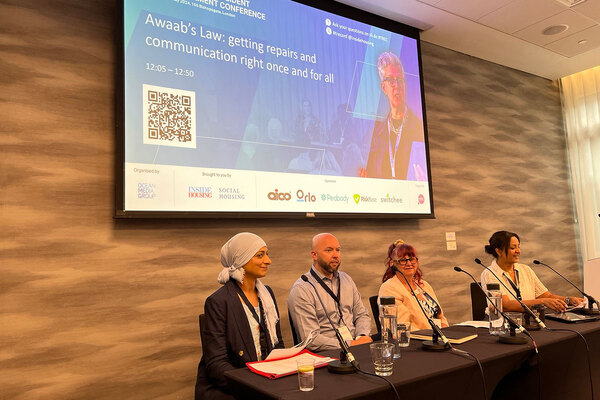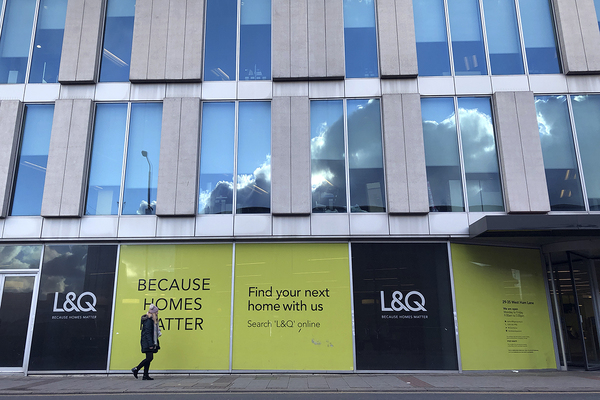You are viewing 1 of your 1 free articles
Landlords can use cladding funding to pay for completed works, government says
Social landlords will be allowed to use new cladding removal funding to pay for work which has already been completed, the government has said.
Housing secretary James Brokenshire wrote to housing associations on Friday to set out the rules of the new £400m of funding to pay for the removal of dangerous cladding in the social sector.
The letter, below, revealed grant funding – which is being taken out of the current round of Affordable Homes Programme spending – would be available even if work has been completed.
It said: “The government is aware that the cost of remediation of [aluminium composite material] ACM cladding systems means building owners are having to take decisions about how to prioritise important services, repairs and maintenance work and new supply.
“We are therefore providing this funding so that they can continue to provide these essential services while also making your buildings safe.”
It added that funding would be available for “removal and replacement of cladding, such as access, scaffolding, materials and labour”.
Councils will still be able to bid for “financial flexibilities”, such as additional borrowing power, to fund the work, it said. Four councils were said to be close to deals of this type in January.
In the letter, Mr Brokenshire said bidders would have to confirm their intention to replace the cladding with “materials which meet A1 and A2 standards” in order to qualify for the cash.
An A2 rating signifies ‘limited combustibility’ while A1 refers to entirely non-combustible materials.
The government has committed to a ban on combustible materials on high rises, following a consultation, although it has not yet set out a detailed proposal.
The letter, sent to chief executives of housing associations and seen by Inside Housing, said: “Because we are providing this funding to social sector landlords, we want them to go further in taking a low risk approach to fire safety. We will therefore be asking them to replace the unsafe cladding on their buildings with non-combustible materials which meet A1 and A2 standards in order to be eligible for the funding.”
In official tests over the summer, the government tested three aluminium cladding materials, listed as category one, two and three depending on their fire resistance.
Only the category one material would have met A2 standards, according to test reports.
The ACM cladding on Grenfell had a Class B, or Class 0, certificate.
The government claims this would have made it non-compliant with building regulations, although many industry figures disagree.
Approved Document B, the official guide to building regulations, says external surfaces of walls must be at least Class B while insulation products must be Class A2, or pass a large-scale tests.
Before Grenfell, government officials had said this would mean Class B was the appropriate standard for cladding, but since the fire they have said it should have been A2, or ‘limited combustibility’.
Letter from James Brokenshire to chief executives of housing associations
I am writing to provide more detail on the Prime Minister’s announcement on 16 May that government will fully fund the removal and replacement of dangerous cladding on buildings owned by councils and housing associations, with costs estimated at £400 million.
I am pleased to say that social sector landlords are getting on with the job of making their buildings safe. We believe we have identified the 158 buildings in the social housing sector which have ACM cladding systems which need to be remediated.
Work has started on two thirds of these, and all have interim fire safety measures in place. However, the Government is aware that the cost of remediation of ACM cladding systems means building owners are having to take decisions about how to prioritise important services, repairs and maintenance work and new supply.
We are therefore providing this funding so that they can continue to provide these essential services while also making your buildings safe. I can confirm that grant funding will be available for the remediation of ACM cladding systems which have failed large-scale tests on residential social housing buildings over 18m owned by local authorities and housing associations.
This will not be means tested, and will be available regardless of whether work has been started, completed or not yet started, so that building owners do not have to worry about the cost of work displacing other activities.
Because we are providing this funding to social sector landlords, we want them to go further in taking a low risk approach to fire safety. We will therefore be asking them to replace the unsafe cladding on their buildings with non-combustible materials which meet A1 and A2 standards in order to be eligible for the funding.
We will then fund reasonable costs associated with the removal and replacement of cladding, such as access, scaffolding, materials and labour. We will also continue to offer local authorities financial flexibilities for other essential work.












